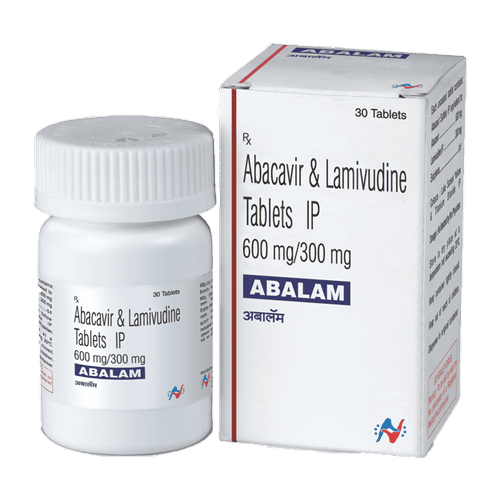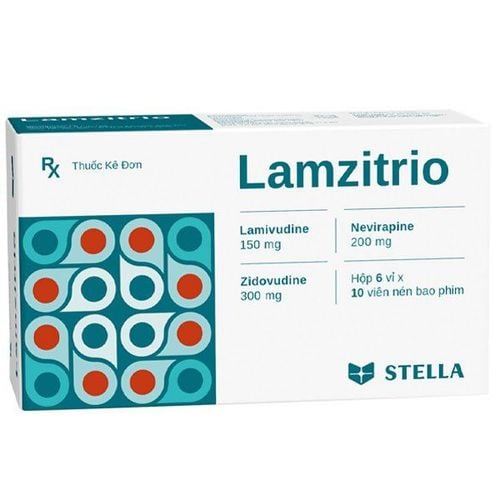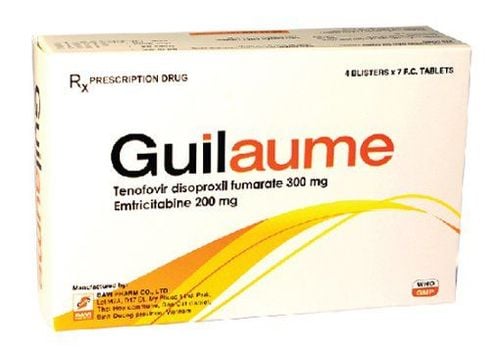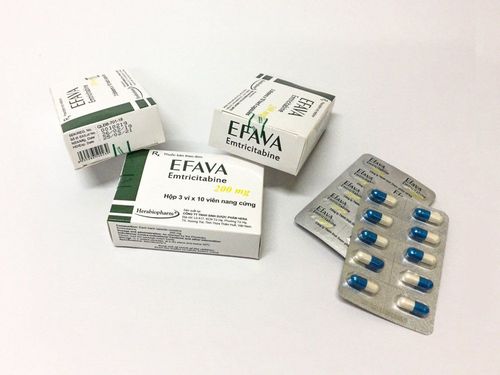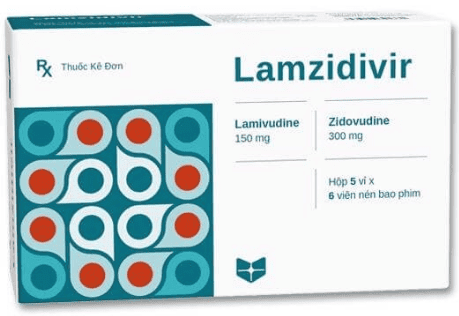This is an automatically translated article.
Fabasofos is a drug commonly used in combination with other antiretroviral drugs to treat HIV-1 infection in adults, adolescents, and children 3 years of age and older. In addition, the drug is also used to prevent HIV infection by reducing the amount of HIV in the body so that the immune system can work better.
1. What are the uses of Fabasofos?
Fabasofos belongs to the antiretroviral group, with the main active ingredient Efavirenz, which inhibits the replication of HIV-1 through a specific inhibitory mechanism on HIV-1 reverse transcriptase.
Fabasofos reduces the amount of HIV in the patient's body so that the immune system can work better, reduces the risk of HIV complications (bacterial superinfection, cancer) and improves the person's quality of life. sick.
2. Indications of the drug Fabasofos
Fabasofos is indicated for use in the following cases:
Used in combination with other antiretroviral agents in the treatment of HIV-1 infection in adults, adolescents and children 3 years of age and older. Prevention for people after occupational HIV exposure. Prevention for people after non-occupational HIV exposure.
3. Contraindications of Fabasofos
Fabasofos is contraindicated in the following cases:
Patients with a history of allergy, hypersensitivity to any ingredient of the drug. The patient has severe liver failure. Pregnant.
4. Dosage and how to use Fabasofos
4.1. How to use Fabasofos drug Fabasofos is prepared in the form of film-coated tablets, 600mg each, for oral use. When swallowing, do not break or crush the tablet. Take the medicine on an empty stomach. Avoid taking the drug with a greasy meal because it will increase drug absorption, causing unwanted effects.
Should take the drug before going to bed to minimize unwanted effects (dizziness, headache, somnolence). After using the drug, if there are no undesirable effects on the central nervous system, the patient can take Fabasofos at a favorable time of the day.
4.2. Dosage of Fabasofos drug Treatment of HIV infection:
Combine Fabasofos with 2 drugs of the Nucleoside class that inhibit reverse transcriptase enzymes: Stavudin (D4T), Lamivudin (3TC), Efavirenz (EFV) or Zidovudin (ZDV) + 3TC + EFV. Adults, adolescents and children ≥ 40kg: 600mg x 1 time/day. Prevention for subjects after occupational exposure:
In combination with other antiretroviral drugs (usually with 2 drugs of the Nucleoside class that inhibit reverse transcriptase). Take 600mg, once a day in the evening before going to bed. The drug must be started within a few hours of exposure and used for 4 weeks. Prevention for subjects after non-occupational exposure:
Combine Fabasofos with 2 other antiretrovirals. Take 600mg, once a day in the evening before going to bed. The drug must be administered within 72 hours of exposure and administered for 28 days. Children 3 years and older: Adjust dose according to weight
Weight from 10 to 15kg: 200mg/time/day, taken with other antiretroviral drugs. Weight from 15 to 20 kg: 250mg / time / day, taken with other antiretroviral drugs. Weight from 20 to 25 kg: 300mg / time / day, taken with other antiretroviral drugs. Weight from 25 to 32.5 kg: 350mg / time / day, taken with other antiretroviral drugs. Weight from 32.5 to 40 kg: 400 mg/time/day, taken with other antiretroviral drugs. Weight from 40kg or more: 600mg/time/day, taken with other antiretroviral drugs. Children under 3 years old:
Use Fabasofos under the guidance of a physician. Patients with renal impairment:
No dose adjustment is necessary because renal clearance is negligible. Patients with hepatic impairment:
No dose adjustment is required in patients with mild hepatic impairment (Child-Pugh A Cirrhosis). Liver enzyme tests should be performed periodically during the use of the drug. Dosage adjustment in combination:
If Fabasofos is co-administered with Voriconazole, the maintenance dose of Voriconazole must be increased to 400 mg every 12 hours and the dose of Fabasofos must be reduced by 50%, i.e. 300 mg once daily. When treatment with Voriconazole is discontinued, the initial dose of Fabasofos should be maintained at 600 mg once daily. If Fabasofos is co-administered with Rifampicin to a patient weighing 50 kg or more, increase the dose of Fabasofos to 800 mg/day. In case the patient forgets a dose of Fabasofos, take it again as soon as possible. However, if it is almost time for your next dose, skip the missed dose and take your next dose of Fabasofos at the indicated time of day. Patients are advised not to double the prescribed dose.
5. Undesirable effects of Fabasofos
Common undesirable effects:
Body as a whole: Fatigue. Nervous system - Psychiatric: Depression, dizziness, headache, insomnia or drowsiness, poor concentration, or dreams, convulsions, anxiety. On the skin: Itching, rash, erythema multiforme. Digestive system: Nausea, vomiting, diarrhea, abdominal distension, dyspepsia. Uncommon side effects:
Urinary system: Kidney stones, blood in urine. Blood: Increased cholesterol and triglycerides in the blood. Digestive system: Pancreatitis. On the Liver: increased liver enzymes (especially in patients with viral hepatitis). Rare adverse effects:
Systemic: Hypersensitivity reactions (pruritus, erythema), Stevens-Johnson syndrome, angioedema. Nervous system - Psychiatric: Headache, confusion, memory loss, dysregulation of movement, sensory disturbances, peripheral neuropathy, hallucinations, abnormal behavior.
6. Precautions when using Fabasofos
When using Fabasofos, patients should note the following information:
Should be used with caution in patients with severe hepatic impairment. During use, it is necessary to monitor liver enzymes in patients with mild to moderate liver disease, especially in patients with viral hepatitis. Discontinue use of Fabasofos if the patient develops severe symptoms of a severe skin rash. , with or without desquamation, mucous membrane adhesions. Monitor blood lipids and blood glucose during treatment with Fabasofos. Nervous system symptoms including: Dizziness, insomnia, somnolence, decreased concentration were frequently encountered in patients receiving Fabasofos. Patients need to talk to their doctor about the symptoms they experience, if they occur, to have an appropriate treatment plan. Seizures: Convulsions have been observed in adults and children receiving Fabasofos, usually in patients with a history of epilepsy and in patients receiving concomitant treatment with other anticonvulsants such as Phenobarbital, Phenytoin, Carbamazepine. These subjects should use caution when using the drug and periodically monitor drug levels in the blood plasma. Taking Fabasofos with food may increase the absorption of the drug and lead to an increased frequency of undesirable effects. It is recommended to take Fabasofos on an empty stomach, preferably before going to bed. Patients should notify their doctor if they experience symptoms of joint pain, stiffness, or difficulty moving. Because in patients with advanced HIV infection and/or long-term combination antiretroviral therapy, osteonecrosis may occur. Fabasofos is not effective against HIV transmission from virus carriers to other healthy people. Therefore, patients treated with efavirenz must still take appropriate measures to avoid transmitting HIV to others (not giving blood, using condoms, etc.). Pregnancy: Fabasofos can be teratogenic if taken during the first 3 months of pregnancy. Women of childbearing potential should not take Fabasofos until the possibility of pregnancy has been ruled out. Lactation: Fabasofos has been shown to be excreted in human milk. Since a risk to the nursing infant cannot be excluded, breastfeeding should be discontinued during treatment with Fabasofos. Women with HIV should not breast-feed under any circumstances to avoid transmitting HIV to their babies. Subjects driving and operating machines: Fabasofos may cause dizziness, impaired concentration and/or somnolence. Patients should avoid hazardous tasks such as driving or operating machinery while taking Fabasofos.
7. Fabasofos drug interactions
When using Fabasofos may interact with some of the following drugs:
Fabasofos can compete with CYP3A4 drugs (Simvastatin and Atorvastatin), thereby increasing the plasma concentration and toxicity of Fabasofos and other drugs. this drug. Fabasofos inhibits the metabolism of the drugs Terfenadine, Benzodiazepines (Midazolam and Triazolam), easily causing serious side effects. Therefore, these drugs should not be used concurrently with Fabasofos. Alcohol and psychotropic drugs increase the effect on the central nervous system, reduce the therapeutic effect as well as increase the unwanted effects of Fabasofos. Fabasofos inhibits the metabolism of Astemizol, Cisapride, increasing the risk of arrhythmias. The combination of Fabasofos with these drugs is contraindicated. Phenobarbital increases the clearance of Fabasofos, thereby reducing the concentration of Fabasofos, reducing the effectiveness of the drug. Rifampicin reduces the concentration of Fabasofos, so the dose of Fabasofos should be increased if co-administered. Fabasofos sharply reduces the concentration of Rifabutin. The dose of rifabutin should be adjusted if used concomitantly. Fabasofos reduces the concentration and effectiveness of oral contraceptives such as Ethinylestradiol. You should use another method of contraception while taking Fabasofos. Fabasofos reduces the concentration of Indinavir, Amprenavir, Atazanavir. The dose of Indinavir should be increased from 800mg every 8 hours to 1000mg every 8 hours if combined with Fabasofos. Fabasofos in combination with Ritonavir increases the frequency of side effects (dizziness, nausea, paresthesia) and increases in liver enzymes. Fabasofos reduces saquinavir concentrations. Saquinavir as a protease inhibitor should not be indicated in combination therapy with Fabasofos. Fabasofos reduces clarithromycin concentrations. It is advisable to choose another antibiotic instead of Clarithromycin such as Azithromycin. Blood levels and effects of Warfarin may be increased or decreased when given concomitantly with Fabasofos. The preparation Hypericum perforatum reduces the concentration of Efavirenz below the effective level and increases the virus resistance. These preparations should not be combined with Fabasofos. With the above information about Fabasofos, hopefully patients will have more knowledge about how to use the drug safely and effectively. If you have any questions about Fabasofos, you should consult your doctor/pharmacist for answers.




